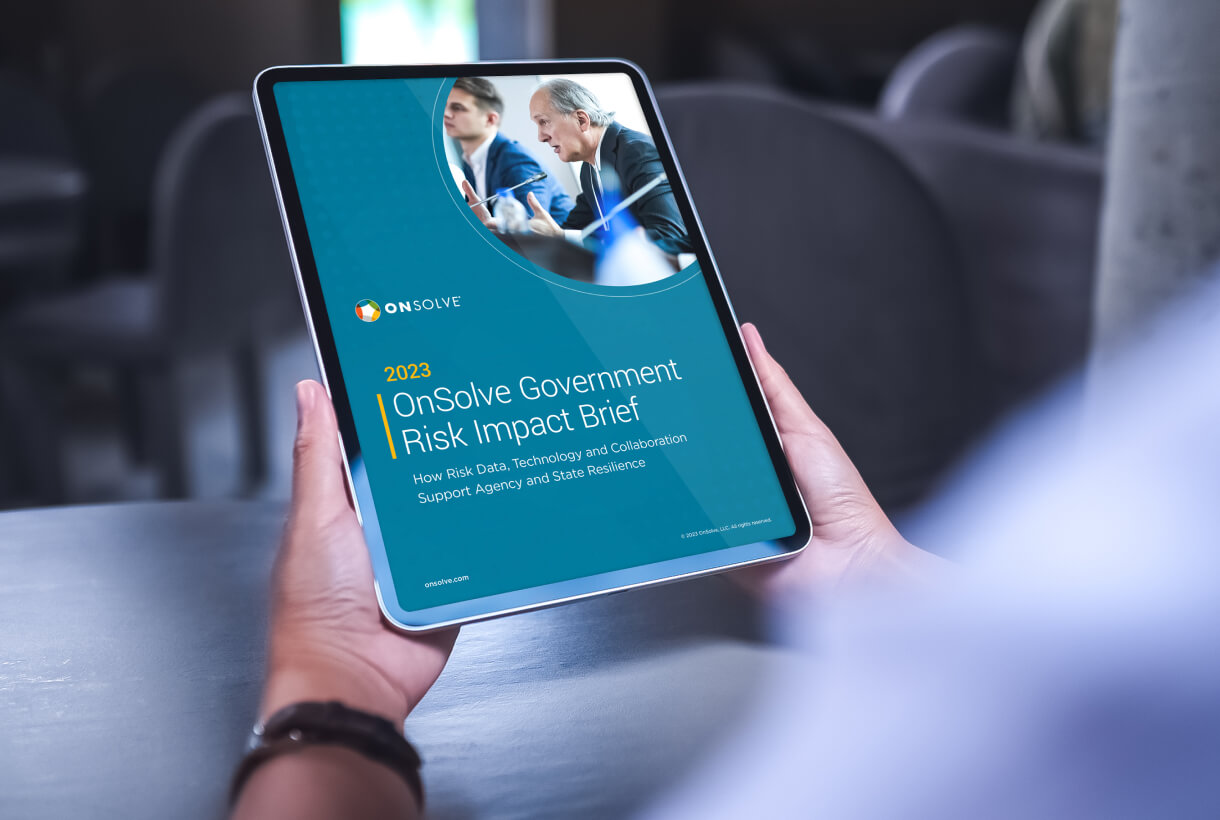Extreme weather. Geopolitical strife. Infrastructure collapse. Rising crime rates. What do all of these risks have in common? None of them happen in a vacuum. These ongoing upheavals all demonstrate the interconnected nature of critical events. For government agencies, the ability to manage a crisis within a crisis has become essential to prevail in today’s highly dynamic risk landscape.
Earlier this year, we witnessed the effects of cascading risk in Texas, when the state faced its second bout of unprecedented extreme winter weather. In a state still reeling from the 2021 freeze that resulted in over $195 billion in damages, the South Central Texas ice storm at the end of January 2023 caused an increase in a number of physical threats. Compared to the two-week period before the storm, there was a 338 percent increase in reports of power outages and a 100 percent increase in reports of theft, according to data from the 2023 OnSolve Government Risk Impact Brief. The storm also had an economic impact, with small businesses experiencing tens of thousands of dollars in losses.
The Texas freeze is only one example of dynamic risk in the form of severe weather. Reports of theft are also posing a threat, accounting for 67 percent of all crime reports in the U.S. in the first half of 2023. Specifically, vehicle theft and retail theft are a concern, representing 35 percent and 16 percent of all theft reports respectively, according to the Global Risk Impact Brief. Increases like these threaten the safety and economic stability of communities.
This butterfly effect from an initial threat makes it more challenging for agencies to manage and mitigate risk. How can emergency managers ensure they’re able to pivot and prevail in this dynamic risk environment?
2023 Government Risk Impact Brief
Government agencies can improve agency resilience with the right combination of risk data, technology and collaboration. Find out how to empower your people to achieve mission success when it comes to public safety.
5 Actions Every Emergency Manager Should Take Today
1. Establish the key factors that WILL matter in the next crisis.
Which core tasks does your organization rely on to remain operational during a critical event? Creating a Continuity of Operations Plan in advance will aid in recognizing those mission-essential functions. During this process, take time to develop a no-fail communications, warning, and notification system. How will you reach everyone? If you don’t already have one, be sure to build a catalog of emergency contacts. Do you have a platform to give your people access to company protocols and training materials? Technology can address all these issues via one convenient mass notification system. It can also be used to run drills to test your communications strategy and operational continuity plan.
2. Illuminate the factors that WON’T matter in the next crisis.
Effective use of resources is vital to successful crisis management. During an emergency, none can be spared for non-essential tasks. That’s why leaders must determine what routine functions can be suspended during a crisis. It’s important to establish how you can reassign resources to address the crisis at hand and take actions that will resolve it as quickly as possible. Then decide when and how you will apply those resources. Timing is everything – with practice you can recognize the decisive moment to maximize their value.
3. Build the team you’ll need to prevail during the next crisis – Now.
Scour your organization for those high performers and surround yourself with them. The people with the experience, skills, and confidence to excel day-to-day are the ones you’ll need during a crisis. To ensure your ability to execute a quick reaction force, the team dynamic should be well-established in advance. Build two-way trust by allowing your people the freedom to act. In the stress and chaos of an emergency, you have to be able to rely on their autonomy. Establish a clear vision and empower your team to execute it in the absence of direct orders.
4. Recognize the capabilities and limitations of your organization.
Proactively invest in the human aspect of the overall mission. By recognizing potential weaknesses and oversights, you can strategize to overcome them via preemptive training and rehearsals. Take advantage of best-in-class technology and generative AI to maximize human performance. AI-powered risk intelligence technology can filter data in real time to identify potential threats, so your team knows where to focus its attention. Don’t wait until your organization is on the brink of failure before seeking assistance. It’s much easier to make a change while still at full strength than after most of your resources have been depleted.
5. Understand risk tolerance – your own and that of your leaders.
Take the time to articulate the problem you’re trying to solve clearly and concisely. By defining what factors are in and out of your control, you can paint a clearer picture for decision-makers. Collect relevant data to inform the range of decisions and support any recommendations offered for consideration. A review of historical risk data can provide insights into trends in the risk landscape in specific geographic locations for a deeper understanding of risk exposure. During an emergency, it’s likely your leader is receiving feedback from a number of other staff. Depending on your familiarity with their risk tolerance, it may be more effective to discuss potential ideas and decisions one-on-one. Finally, refine your decision matrix and take calculated action.
Ready to take charge of risk and turn the tide?
To learn more about embracing risk, building agency resilience and creating a wave of stronger outcomes in a dynamic threat landscape, register for my Leading During Crisis masterclass at www.femapete.com.


